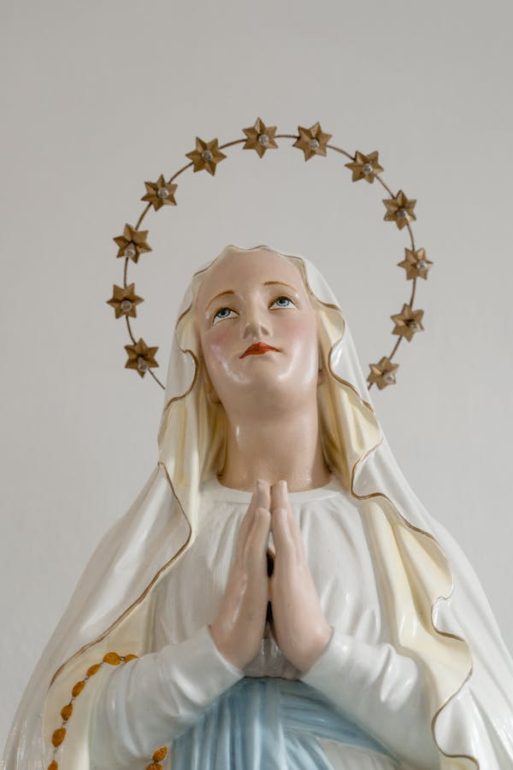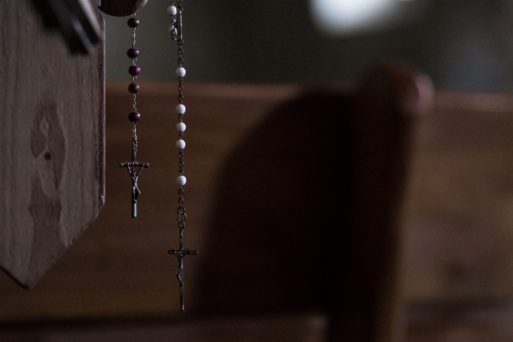
For many Catholic Americans, praying the rosary holds deep significance and can be a meaningful part of Catholic funeral rites. A rosary is a Roman Catholic devotional prayer that invites the speaker to meditate on the mysteries of Christ and draw close to His mother, the Virgin Mary. In Catholic belief, the Virgin Mary and the saints who came before are powerful intercessors on our behalf with God. They believe that when we pray to Mary or the saints, they can bring our prayers to God and magnify them. The rosary can be prayed at any time, either alone or in a group, but is particularly utilized by Catholic communities to rally people together in prayer during times of need, distress or grief.
The rosary is typically recited with the help of prayer beads, named rosary beads, to guide the speaker. While rosary beads may at first glance look like a regular necklace, special thought was placed in the design to help deepen the prayer. Rosary beads consist of a crucifix, followed by a large bead, three small beads, and another large bead. These are connected to five sets of one large bead and 10 small beads. Each of these sets is referred to as a “decade,” because of the 10 small beads. The size and placing of the beads lead the speaker through a series of prayers, starting with praying the Apostles’ Creed (a statement of belief in God and the Holy Church) at the crucifix. As the speaker’s clasped hands move through the rosary beads, each large bead is an invitation to pray “Our Father,” (a classic prayer to God), and each small bead is a reminder to pray “Hail Mary,” (a beloved Catholic prayer praising the Virgin Mary and petitioning her to pray on our behalf). After each decade of the “Hail Marys” is completed, the speaker is invited to pray “Glory Be” (a praise to God, Jesus, and the Holy Spirit).

The rosary asks the Virgin Mary to intercede on our behalf
In total, the rosary beads guide the speaker to pray 53 “Hail Marys,” six “Our Fathers,” five “Glory Bes,”and seven other prayers. As the prayers are recited, the person is also invited to meditate on the various mysteries of the life of Jesus Christ. A full rosary typically takes about 20 minutes to complete, and can be a rewarding experience of prayer for practicing Catholics that connects them to God, Mary, and the communion of saints.
The Rosary as a Catholic Funeral Rite
In traditional Catholic funeral services, it is common to incorporate a rosary service in the setting of a wake or vigil the evening before the burial. The prayers are often led by a priest, but could be led by any member of the community. Typically, the rosary service is open to Catholics and non-Catholics, and the rosary can be prayed by anyone who has a connection to the prayers. It can also be a time of silent prayer for non-Catholics. The rosary service often segues into a visitation time for the body.
The rosary is said in part to pray for the soul of the deceased to be granted eternal rest with God. But just as importantly, praying the rosary at a wake is an acknowledgement that the deceased has entered into the communion of saints. Former Jesuit Volunteer John Corgan explained,
“We often place a rosary in the deceased person’s hands, as though they’re still thumbing the beads…. The implication in Catholic belief is an ongoing link between the living and the dead, with the saints interceding for us and us praying for the dead, everybody basically praying for each other.”
Albert Honegan shared vivid memories of tenderly wrapping a rosary around his grandparents’ hands in their casket. In this manner, the living and the dead both join together in prayer a reassuring reminder that for Catholics, eternal life continues after death.

Father Chris Hadley, S.J., also shared his perspective that the rosary is helpful during Catholic funeral rites because it provides a structure for how people can be together and support each other in grief. Because the prayers have a predetermined rhythm and wording that is well known, it provides a concrete, communal action without the pressure of trying to guess how to express support. Fr. Hadley elaborated:
“The rosary provides a structure for grief to rest on…. It helps people stay together with each other during a time of grief where they don’t have to worry about what to do or say…. It gives you some sense of refuge and then at the end, a feeling that something has been done, a communal expression of closure.”
Fr. Hadley explained that the rosary service typically happens at the wake when the body is viewed, and that it can be an important part of accepting the reality of the loss.
Not all Catholics choose to include a rosary service in the funeral planning, however. Catholic teacher Catherine Holcombe speculated that the rosary service tends to be more popular in different ethnic communities, and offered Filipino and Mexican communities as an example. Fr. Hadley echoed Holcombe’s sentiments by sharing that when he served the Omak reservation in Washington, a rosary service was a crucial part of almost every funeral service he did, and that the community relied on the rosary greatly to guide them in their bereavement.
Praying the rosary can also be a powerful grieving tool for families or communities struggling with grief, even long after the funeral services. Matthew Mackarevich shared that when his mother was 10, her father died, leaving behind an impoverished widow and five young children. The family faced intense grief alongside a dire lack of income, and in desperation, came together each night as a family to pray the rosary. The family’s fortunes improved, and they credit the rosary for allowing them to all continue living together as a family, and also strengthening their bond that continues decades later. Mackarevich explained that the rosary is “a unifying force when prayed together.” Though the rosary may seem simple, it provides deep comfort for many Catholics during times of bereavement.

 Praying the Rosary: A Catholic Funeral Rite
Praying the Rosary: A Catholic Funeral Rite


 “Hand to Earth” by Andy Goldsworthy
“Hand to Earth” by Andy Goldsworthy
 Trans Remembrance Project Provides a Community of Grieving
Trans Remembrance Project Provides a Community of Grieving
 Caring for a Dying Loved One? Be Gentle With Yourself.
Caring for a Dying Loved One? Be Gentle With Yourself.














